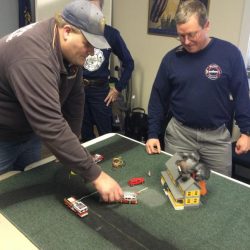Emergency scene size up can be defined as “A rapid mental evaluation of various factors related to an emergency incident”, or “An initial on-scene report by the first arriving unit that is clear, concise and relevant”.
The fire service loves acronyms and of course we have some for scene size-up. Some of these acronyms are long and difficult to remember. This one for example, COAL WAS WEALTH, may be easy to remember until you try to recall what all the letters stand for. Here they are;
Construction, Occupancy, Apparatus (and staffing), Life hazard, Water supply, Auxiliary appliances, Street conditions, Weather, Exposures, Area (including height), Location of fire within the structure, Time, and Hazards/Hazardous materials. While it is good practice to consider all of these during an initial scene size up, practice and experience are needed to become efficient at using it.
Another easier acronym is “A-B-C-D Size-up”. This is an easy one to remember and can especially be used by any firefighter or officer who is first on the scene. The letters stand for;
A- Address- Sometimes the address you receive is not the address of the incident
B- Building Description- Includes construction, floors, and occupancy
C- Conditions- Smoke and or fire conditions, location of fire, weather conditions
D- Deployment and directives- Which operational mode, (investigating, rescue, offensive or defensive). Provide additional instructions to specific units or to dispatch.
There have been thousands (I’m guessing) of articles, books, and training sessions devoted to scene size up. As humans, we all do size up every day. When we meet someone new, look at new apparatus, read an article, or sit in training, we are performing a mental size up of what we think about any of those particular items. And there are a ton of size ups we do in our everyday off duty life. It really is not that hard and is certainly something we shouldn’t be intimidated by. Take the first example above, COAL WAS WEALTH, and once you see what the letters stand for, you realize that you don’t really need to memorize each word in the acronym. Most of what you do in your initial size up is included in the first two words, COAL and WAS.
A sample size up could be something like this;
Engine X on scene of a one story, wood frame residential structure with smoke showing from side B. There is no apparent life hazard, the street is clear for placement, have Engine W secure a water supply. The only letter missed was A for Apparatus, and we should know how our units are staffed before we leave the station. I would include exposures in the initial size up, if there are any, we know what the weather is, and fire is close to or at Side B. So we hit all the letters without mentally checking them off. As a last item and after taking command, the officer should report the mode he is in (fire attack, rescue, protect exposures, passing command to another unit on scene, etc).
We must remember there usually is not a lot of time to identify these points, develop a plan of action, communicate that plan to incoming units, and start whatever action you have decided on. Most of the time putting the fire out is the plan and may be done before other units arrive. However, we cannot fail to mentally develop a plan and communicate it so others, including whatever ranking officer is responding, will know what you are doing.
The objective is to implement a structured size-up process in your department, then educating your officers and firefighters in your department’s size-up policy.
Remember to stay safe – “Everyone Goes Home”
William Jolley has 37 years of experience in the fire service with 20 of those years in a management position. William was the Fire Chief of Haines City, Florida, a city of Approximately 20,000. Prior to that William was the Assistant Chief of Saint Petersburg, Florida, where he worked for 35 years.



